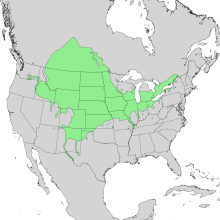Salix amygdaloides, the almond leaf willow or peach leaf willow, is a species of willow native to central North America east of the Cascade Range.[2] It can be found in southern Canada and the United States—from western British Columbia to Quebec, Idaho, Montana and Arizona to eastern Kentucky.[3] As of 2022, it is presumed extirpated from the state of Kentucky.[4]
| Salix amygdaloides | |
|---|---|
 | |
| Peachleaf willow leaves | |
| Scientific classification | |
| Kingdom: | Plantae |
| Clade: | Tracheophytes |
| Clade: | Angiosperms |
| Clade: | Eudicots |
| Clade: | Rosids |
| Order: | Malpighiales |
| Family: | Salicaceae |
| Genus: | Salix |
| Species: | S. amygdaloides |
| Binomial name | |
| Salix amygdaloides | |
 | |
| Natural range | |
It is a small to medium-sized deciduous tree, growing to 4–20 metres (13–66 ft) tall; besides the cottonwoods, it is the largest tree native to the prairies. It has a single trunk, or sometimes several shorter trunks. The leaves are lanceolate, 3–13 centimetres (1+1⁄4–5 in) long and 1–4 cm (1⁄2–1+1⁄2 in) wide, yellowish green with a pale, whitish underside and a finely serrated margin. The flowers are yellow catkins, 3–8 cm (1+1⁄4–3+1⁄4 in) long, produced in the spring with the leaves. The reddish-yellow fruit matures in late spring or early summer, and the individual capsules are 4–6 millimetres (3⁄16–1⁄4 in) long.[5][6]
The peachleaf willow grows very quickly, but is short-lived. It can be found on the northern prairies, often near streams, and accompanying cottonwoods. As the common and scientific names suggest, the leaves bear some similarity to those of a peach and (even more so) of an almond.[2]
References
External links
Wikiwand in your browser!
Seamless Wikipedia browsing. On steroids.
Every time you click a link to Wikipedia, Wiktionary or Wikiquote in your browser's search results, it will show the modern Wikiwand interface.
Wikiwand extension is a five stars, simple, with minimum permission required to keep your browsing private, safe and transparent.

